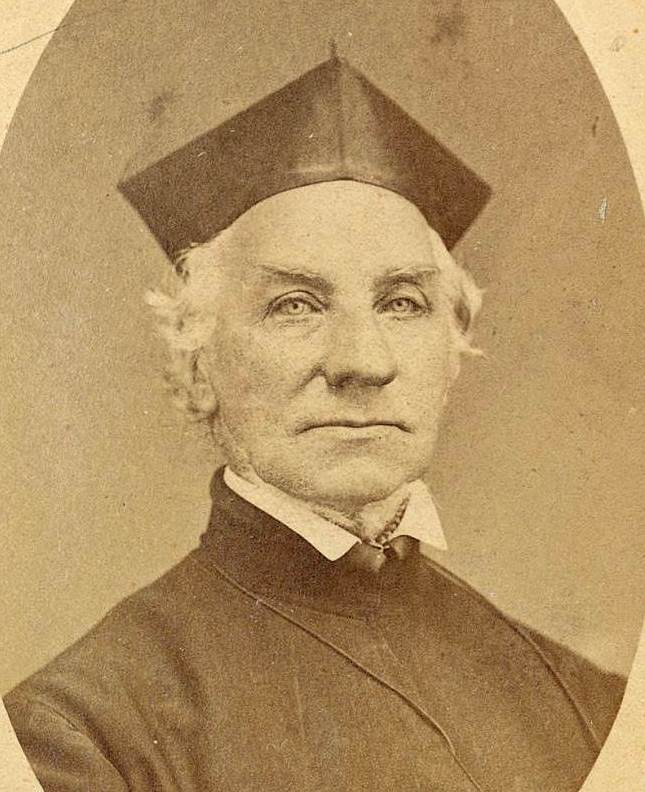Gregorio Mengarini
Pioneer missionary of the Flathead tribe and philologist of their language, b. in Rome, 21 July, 1811; d. at Santa Clara, California, 23 September, 1886. He entered the Jesuit novitiate in 1828, when barely seventeen, and later served as instructor in grammar, for which his philological bent particularly fitted him, at Rome, Medina, and Reggio. While studying at the Rome College in 1839, a letter of Bishop Rosati of St. Louis, voicing the appeal of the Flatheads for missionary priests, was read out in the refectory, and Mengarini was at once moved to volunteer for the work. Ordained in March, 1840, he sailed with Father Cotling, another volunteer, from Leghorn on 23 July, and after a tedious nine weeks’ voyage landed at Philadelphia. From Baltimore the missionaries found their way to the University of Georgetown, District of Columbia, and a little later to St. Louis, where it was decided Father Cotling should remain. Mengarini was chosen for the distant mission of the upper Missouri, partly on account of his voice and knowledge of music – possessions of no little value in Indian mission work. On 24 April, 1841, Father de Smet, Mengarini, and Point, with the lay brother Specht, Huett, and Classens, and nine other companions, began the long journey by river and overland trail to Fort Hall, Idaho, then a trading post, where they arrived on the feast of the Assumption (15 August) and found a party of Flatheads waiting to conduct them to their final destination. It was nearly a month later when they arrived at the chosen site on St. Mary’s river, Montana, in the Flathead country, and began the foundations of the log mission, the missionaries themselves leading the work of cutting the frozen earth with axes. The church and house were of logs plastered between with clay, and were thatched with weeds, the rooms being partitioned with curtains of deerskin and thin scraped deerskin being used in lieu of glass for the windows. The winter cold was so intense that the buffalo skin robes in which they wrapped themselves at night were frozen stiff and had to be thawed out each morning. To the native of sunny Italy these early winters in Montana mountains were among the most vivid recollections of later years.
 The missionaries at once began the study of the language, translating into it simple prayers and hymns. Mengarini composed a Salish grammar which is still the standard for the cognate dialects. He taught the children to sing in Salish hymns of his own composition, and even trained an Indian band for service on feast days. The work progressed until 1849, when in consequence of the inroads of the Blackfeet and the defection and relapse of a large part of the Flathead tribe under a rival claimant for the chieftainship it was decided to close the mission, and Mengarini was summoned to join Father Accolti, the superior of the north-western Jesuit missions, in Oregon. About a year later, on request of Archbishop Alemany of San Francisco for Jesuit workers, he was sent to aid in establishing at Santa Clara the Californian mission which was the nucleus of the present college. In the mean time the repentant Flatheads had sent to Oregon to ask for his return. They were told this was impossible as he was assigned to another station, but on their urgent desire, the Flathead mission was re-established at St. Ignatius in 1851. Mengarini was stationed at Santa Clara for the rest of his life, acting for thirty years as treasurer or vice-president, until a stroke of apoplexy and failing sight caused his retirement from active duties. The hardest trial came when his eyes became too weak to allow him to read Mass. A third stroke of apoplexy ended his life’s work in his seventy-sixth year.
The missionaries at once began the study of the language, translating into it simple prayers and hymns. Mengarini composed a Salish grammar which is still the standard for the cognate dialects. He taught the children to sing in Salish hymns of his own composition, and even trained an Indian band for service on feast days. The work progressed until 1849, when in consequence of the inroads of the Blackfeet and the defection and relapse of a large part of the Flathead tribe under a rival claimant for the chieftainship it was decided to close the mission, and Mengarini was summoned to join Father Accolti, the superior of the north-western Jesuit missions, in Oregon. About a year later, on request of Archbishop Alemany of San Francisco for Jesuit workers, he was sent to aid in establishing at Santa Clara the Californian mission which was the nucleus of the present college. In the mean time the repentant Flatheads had sent to Oregon to ask for his return. They were told this was impossible as he was assigned to another station, but on their urgent desire, the Flathead mission was re-established at St. Ignatius in 1851. Mengarini was stationed at Santa Clara for the rest of his life, acting for thirty years as treasurer or vice-president, until a stroke of apoplexy and failing sight caused his retirement from active duties. The hardest trial came when his eyes became too weak to allow him to read Mass. A third stroke of apoplexy ended his life’s work in his seventy-sixth year.
Mengarini’s principal contribution to philology is his “Selish or Flathead Grammar: Grammatica linguæ Selicæ” – published by the Cromoisy Press (New York, 1861) from the third manuscript copy, the first two, laboriously written out by him, having been lost by Indian carelessness or accident. Originally intended solely for the use of the missionaries, it was written in Latin, and he himself always said the first draft was the most correct. He also furnished vocabularies of the cognate Salishan languages – of Shw oyelpi (Colville), S’chitzui (Coeur d’Alene) and Salish proper (Flathead) in Powell’s “Contributions to North American Ethnology”, I (Washington, 1877), and of the Santa Clara dialect of California in Powers’s “Tribes of California”, volume III of the same series, published in the same year. He contributed some linguistic notes in the “Journal of the Anthropological Institute of New York”, I (1871-2). His interesting personal memoir, “The Rocky Mountains”, published in the Woodstock Letters for 1888, was dictated a few months before his death.
In addition to the memoir just mentioned, consult Obituary Notice in Woodstock Letters XVI (Woodstock, Maryland, 1887); SOMMERVOGEL, Bibl. de la C. de J., Bibliogr., V (new ed., Brussels and Paris, 1894); PILING, Bibliography of the Salishan Languages in Bur. Amer. Ethnology (Washington, 1893); SHEA, Catholic Missions (New York, 1864).
JAMES MOONEY (Catholic Encyclopedia)









